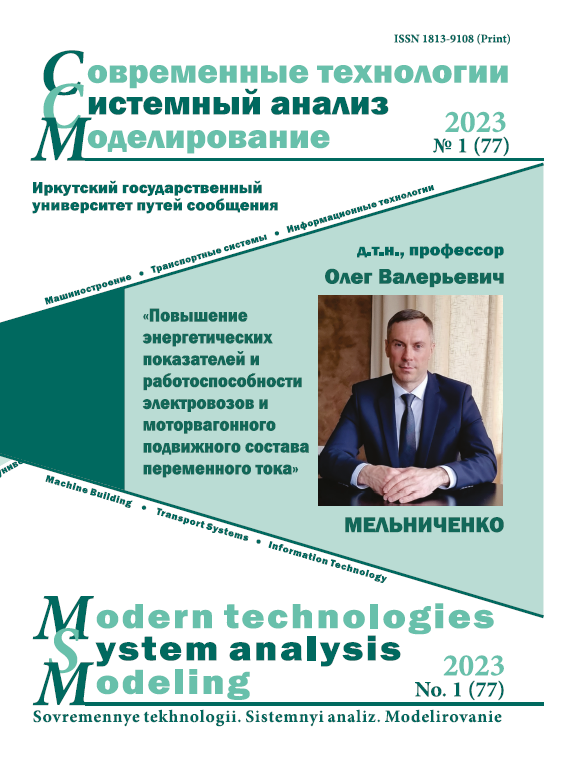Application of the Mamdani fuzzy logic algorithm to assess the quality of artificial intelligence models based on available data
Keywords:
artificial intelligence, data quality, fuzzy logic methods, Mamdani algorithm, data quality assessment criteriaAbstract
This paper considers the actual problem of laboriousness and high cost of developing systems or models of artificial intelligence due to the low quality of the data used. The types and directions of the correlation between various metrics of data quality and the accuracy of the final artificial intelligence model are studied. It is noted that in the modern world there is a penetration of artificial intelligence into almost all areas of human activity: healthcare, agri-food, industry, creative areas. The relevance of the problem posed is substantiated and a brief review of modern studies related to the study of the correlation between data quality and artificial intelligence accuracy is carried out. It is noted that bad data lead to significant financial losses, increases the complexity of developing artificial intelligence systems or models. Based on the research conducted in various areas of artificial intelligence application, five characteristics of big data affecting the accuracy of the developed artificial intelligence have been identified: inconsistency, incompleteness, invalidity, noisiness, sample size. To determine the desired dependencies, the Mamdani fuzzy logic algorithm was chosen. Criteria for assessing data quality are converted into terms with fuzzy triangular numbers and fuzzy inference rules are formed. Dependence graphs are constructed and conclusions are drawn about the most important data quality criteria. High noise or data inconsistency are acceptable only in small quantities, but the accuracy of models drops sharply when these characteristics are enhanced, incompleteness or invalidity are less critical for the quality of models, increasing the sample size has a significant impact either with high model complexity or with a relatively small initial sample.
References
Purdy M., Daugherty P. How AI Boosts Industry Profits and Innovation. Dublin : Accenture Institute for High Per-formance, 2017. 28 p.
Overview of artificial intelligence in medicine / P. Amisha, M. Malik, Pathania et al. // Journal of Family Medicine and Primary Care. 2019. № 8 (7). Р. 2328–2331. DOI 10.4103/jfmpc.jfmpc_440_19.
Baruchelli P., Botto F., Cimatti A. Overview on maturity of AI innovations in manufacturing. URL: https://eit.europa.eu/sites/default/files/overview_on_maturity_of_ai_innovations_in_manufacturing_20529-d11.pdf (Аccess date 21.10.2022).
Mhlanga D. Artificial Intelligence in the Industry 4.0, and Its Impact on Poverty, Innovation, Infrastructure Devel-opment, and the Sustainable Development Goals: Lessons from Emerging Economies? URL: https://www.mdpi.com/2071-1050/13/11/5788 (Аccess date 21.10.2022).
Mingyong C. The Creativity of Artificial Intelligence in Art // Proceedings of the 2021 Summit of the International Society for the Study of Information. Sendai, Los Angeles, 2021. Vol. 81, Iss. 1. URL: https://www.mdpi.com/2504-3900/81/1/110 (Аccess date 21.10.2022).
Mun J., Housel T.J., Jones R.D. Acquiring artificial intelligence systems: Development challenges, implementation risks, and cost/benefits opportunities. URL: https://www.researchgate.net/publication/351703250_Acquiring_Artificial_Intelligence_ Sys-tems_Development_Challenges_Implementation_Risks_and_CostBenefits_Opportunities (Аccess date 21.10.2022).
Everyone wants to work with a model, not with data: data cascades in high-stakes AI / N. Sambasivan, S. Kapania, H. Highfill et al. // Proceedings of the 2021 CHI Conference on Human Factors in Computing Systems. Yokohama, 2021. URL: https://dl.acm.org/doi/pdf/10.1145/3411764.3445518 (Аccess date 21.10.2022).
Shafei S. Data quality for everyday analysis // Towards Data Science, 2020. URL: https://towardsdatascience.com/data-quality-for-everyday-analysis-d3aa1442c31 (access date 21.10.2022).
Assessing the impact of expert labelling of training data on the quality of automatic classification of lithological groups using artificial neural networks / Y. Kuchin, R.I. Mukhamediev, K. Yakunin et al. // Applied Computer Systems. 2020. Vol. 25. № 2. Р. 145–152.
Azimi S., Pahl C. The Impact of Data Completeness and Correctness on Explainable Machine Learning Models // Journal of Data Intelligence. 2022. Vol. 3. № 2. Р. 218–231.
Deep learning with noisy labels: Exploring techniques and remedies in medical image analysis / D. Karimi, H. Dou, S.K. Warfield et al. // Medical Image Analysis. 2020. Vol. 65. № 5. Р. 101759. DOI: 10.1016/j.media.2020.101759.
The influence of training sample size on the accuracy of deep learning models for the prediction of soil properties with near-infrared spectroscopy data / Ng Wartini, B. Minasny, W. de S. Mendes et al. // Soil. 2020. Vol. 6, № 2. Р. 565–578.
Болодурина И.П., Дусакаева С.Т. Введение в теорию нечетких множеств и систем. Оренбург : ОГУ, 2021. 172 с.
Киселев В.Ю., Калугина Т.Ф. Теория нечетких множеств и нечеткая логика. Задачи и упражнения. Иваново : ИГЭУ, 2019. 72 с.
Тихомирова А.Н., Клейменова М.Г. Нечеткие модели дискретной математики. М. : НИЯУ МИФИ, 2011. 108 с.
Хижняков Ю.Н. Алгоритмы нечеткого, нейронного и нейро-нечеткого управления в системах реального време-ни. Пермь : ПНИПУ, 2013. 156 с.
Хижняков Ю.Н. Нечеткое, нейронное и гибридное управление. Пермь : ПНИПУ, 2013. 303 с.
Бахусова Е.А. Элементы теории нечетких множеств. Тольятти : ТГУ, 2013. 116 с.
Зак Ю.А. Принятие решений в условиях нечетких и размытых данных: Fuzzy-Технологии. М. : Либроком, 2013. 352 с.
Frank H. Fuzzy Methoden in der Wirtschaftsmathematik. Braunschweig. Wiesbaden : Vieweg & Sohn Verlag, 2002. 242 p.
Friedrich A. Logik und Fuzzy-Logik. Stuttgart : Expert Verlag, 2006. 319 p.
Тэрано Т., Асаи К., Сугэно М. Прикладные нечеткие системы. М. : Мир, 1993. 368 с.


